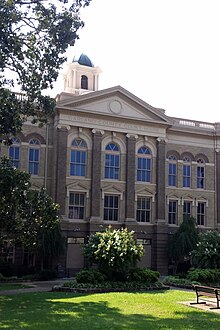Garland County, Arkansas
| Garland County, Arkansas | |
|---|---|

Garland County Courthouse
|
|
 Location in the U.S. state of Arkansas |
|
 Arkansas's location in the U.S. |
|
| Founded | April 5, 1873 |
| Named for | Augustus Hill Garland |
| Seat | Hot Springs |
| Largest city | Hot Springs |
| Area | |
| • Total | 735 sq mi (1,904 km2) |
| • Land | 678 sq mi (1,756 km2) |
| • Water | 57 sq mi (148 km2), 7.7% |
| Population (est.) | |
| • (2015) | 97,177 |
| • Density | 142/sq mi (55/km²) |
| Congressional district | 4th |
| Time zone | Central: UTC-6/-5 |
| Website | www |
Garland County is a county located in the U.S. state of Arkansas. As of the 2010 census, the population was 96,024. The county seat is Hot Springs.
Garland County comprises the Hot Springs, AR Metropolitan Statistical Area. The county includes Hot Springs National Park, the first property to be protected under federal legislation; a law was passed in 1832 supported by President Andrew Jackson to preserve this area, even before Arkansas was admitted as a state.
This area was occupied by the historic , who frequented the hot springs for their healing powers. Their ancestors among regional indigenous peoples had been coming to this area for thousands of years.
President Thomas Jefferson requested William Dunbar, a planter and amateur scientist of Natchez, to explore this area. Dunbar led small group of a dozen soldiers and friend George Hunter, a chemist, to the Ouachita Mountains to report on the Indian tribes, minerals, and springs. They reached Hot Springs in December 1804, where they found a basic cabin used by visitors to the springs.
The first European-American settler was Jean Pierre Emanuel Prudhomme, a descendant of French colonists. An owner of a plantation at Red River, Prudhomme was suffering from illness and sought relief from the springs. In 1807 He built the first permanent European house by the springs, living here for two years. Isaac Cates and John Percival, two trappers from Alabama, joined him. Percival foresaw a great potential for the area and built log cabins in order to rent to visitors to the springs.
In 1828, Ludovicus Belding came with wife and children to visit the hot springs. After a few months they built a small hotel for the visitors of the springs.
In 1832 President Andrew Jackson signed legislation to protect the hot springs area for recreational use by American citizens as Hot Springs Reservation, the first time such action was taken. This was four years before Arkansas became a state, on June 15, 1836. A dispute among original settlers and their descendants over control of the property was settled by the US Supreme Court in 1877 in favor of the federal government.Hot Springs National Park was established in 1921 and is managed by the National Park Service. Garland County is Arkansas' 68th county, formed on April 5, 1873, from portions of Hot Spring, Montgomery, and Saline Counties. It was named for Augustus H. Garland, eleventh governor of Arkansas.
...
Wikipedia
